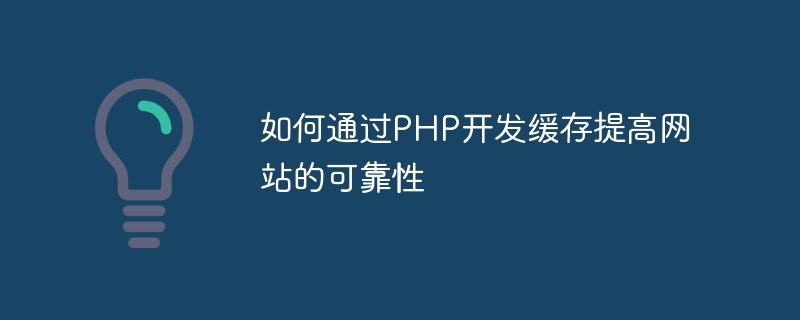

How to improve the reliability of the website through PHP cache development
Cache is a very important technology in website development. Caching can improve the access speed and speed of the website. reliability. In PHP development, we can use different caching technologies to improve the performance of the website. This article will introduce how to develop cache through PHP to improve the reliability of the website, and give specific code examples.
1. What is cache
Cache is a technology that temporarily stores data or calculation results in high-speed memory for subsequent quick access. In website development, caching can be divided into multiple levels, including browser caching, CDN caching, server caching, etc. This article mainly discusses server-side caching.
2. Why use cache
3. How to use caching
In PHP development, we can use a variety of caching technologies to improve the reliability of the website. Two commonly used caching technologies will be introduced below: file caching and Redis caching.
File caching is a simple and commonly used caching technology that saves data in files for subsequent use. The following is a sample code using file caching:
<?php
function get_data_from_cache($key, $expiration = 3600) {
// 检查缓存文件是否存在并且没有过期
$cache_file = 'cache/' . md5($key) . '.txt';
if (file_exists($cache_file) && (filemtime($cache_file) + $expiration >= time())) {
// 缓存文件存在且没有过期,直接从缓存文件读取数据
return file_get_contents($cache_file);
} else {
// 缓存文件不存在或者已过期,重新生成数据并保存到缓存文件中
$data = generate_data(); // 生成数据的函数
file_put_contents($cache_file, $data);
return $data;
}
}In the above code, we use a get_data_from_cache function to obtain cache data. First, we check whether the cache file exists and has not expired. If so, read the data directly from the cache file and return it; otherwise, regenerate the data and save it to the cache file.
Redis is an in-memory database with high-speed reading, writing and persistence capabilities. It is a technology that is very suitable for caching. The following is a sample code using Redis cache:
<?php
$redis = new Redis();
$redis->connect('127.0.0.1', 6379);
function get_data_from_cache($key, $expiration = 3600) {
global $redis;
$data = $redis->get($key);
if (!$data) {
$data = generate_data(); // 生成数据的函数
$redis->setex($key, $expiration, $data); // 设置缓存数据并设置过期时间
}
return $data;
} In the above code, we first connect to the Redis database and define a get_data_from_cache function to obtain cached data. We get cached data from Redis through the $redis->get($key) method. If the cached data does not exist, regenerate the data and use $redis->setex($ key, $expiration, $data)method to set cache data and set expiration time.
4. Caching precautions
When using cache, there are some precautions to pay attention to:
Summary:
By using PHP to develop cache, we can improve the access speed and reliability of the website. In actual development, you can choose appropriate caching technology according to specific needs, and pay attention to issues such as cache update and invalidation. Through the reasonable use of caching technology, we can provide users with a better website experience and improve the reliability and performance of the website.
(Note: The above code is for reference only, and needs to be modified and optimized according to specific circumstances in actual applications.)
The above is the detailed content of How to improve website reliability through PHP cache development. For more information, please follow other related articles on the PHP Chinese website!